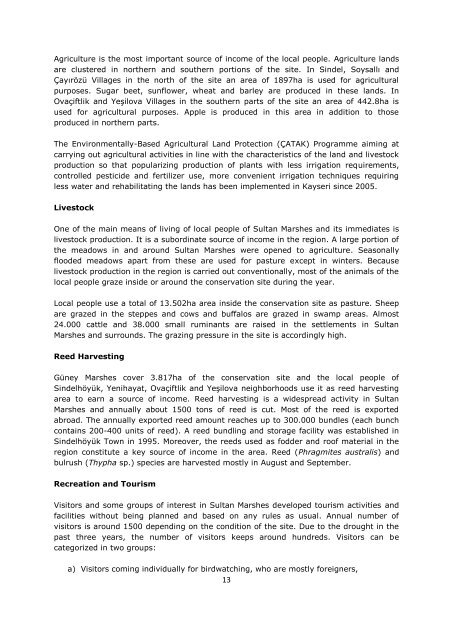Ramsar Sites of Turkey - Ramsar Convention on Wetlands
Ramsar Sites of Turkey - Ramsar Convention on Wetlands
Ramsar Sites of Turkey - Ramsar Convention on Wetlands
You also want an ePaper? Increase the reach of your titles
YUMPU automatically turns print PDFs into web optimized ePapers that Google loves.
Agriculture is the most important source <str<strong>on</strong>g>of</str<strong>on</strong>g> income <str<strong>on</strong>g>of</str<strong>on</strong>g> the local people. Agriculture lands<br />
are clustered in northern and southern porti<strong>on</strong>s <str<strong>on</strong>g>of</str<strong>on</strong>g> the site. In <br />
illages in the north <str<strong>on</strong>g>of</str<strong>on</strong>g> the site an area <str<strong>on</strong>g>of</str<strong>on</strong>g> 1897ha is used for agricultural<br />
purposes. Sugar beet, sunflower, wheat and barley are produced in these lands. In<br />
<br />
used for agricultural purposes. Apple is produced in this area in additi<strong>on</strong> to those<br />
produced in northern parts.<br />
The Envir<strong>on</strong>mentally- <br />
carrying out agricultural activities in line with the characteristics <str<strong>on</strong>g>of</str<strong>on</strong>g> the land and livestock<br />
producti<strong>on</strong> so that popularizing producti<strong>on</strong> <str<strong>on</strong>g>of</str<strong>on</strong>g> plants with less irrigati<strong>on</strong> requirements,<br />
c<strong>on</strong>trolled pesticide and fertilizer use, more c<strong>on</strong>venient irrigati<strong>on</strong> techniques requiring<br />
less water and rehabilitating the lands has been implemented in Kayseri since 2005.<br />
Livestock<br />
One <str<strong>on</strong>g>of</str<strong>on</strong>g> the main means <str<strong>on</strong>g>of</str<strong>on</strong>g> living <str<strong>on</strong>g>of</str<strong>on</strong>g> local people <str<strong>on</strong>g>of</str<strong>on</strong>g> Sultan Marshes and its immediates is<br />
livestock producti<strong>on</strong>. It is a subordinate source <str<strong>on</strong>g>of</str<strong>on</strong>g> income in the regi<strong>on</strong>. A large porti<strong>on</strong> <str<strong>on</strong>g>of</str<strong>on</strong>g><br />
the meadows in and around Sultan Marshes were opened to agriculture. Seas<strong>on</strong>ally<br />
flooded meadows apart from these are used for pasture except in winters. Because<br />
livestock producti<strong>on</strong> in the regi<strong>on</strong> is carried out c<strong>on</strong>venti<strong>on</strong>ally, most <str<strong>on</strong>g>of</str<strong>on</strong>g> the animals <str<strong>on</strong>g>of</str<strong>on</strong>g> the<br />
local people graze inside or around the c<strong>on</strong>servati<strong>on</strong> site during the year.<br />
Local people use a total <str<strong>on</strong>g>of</str<strong>on</strong>g> 13.502ha area inside the c<strong>on</strong>servati<strong>on</strong> site as pasture. Sheep<br />
are grazed in the steppes and cows and buffalos are grazed in swamp areas. Almost<br />
24.000 cattle and 38.000 small ruminants are raised in the settlements in Sultan<br />
Marshes and surrounds. The grazing pressure in the site is accordingly high.<br />
Reed Harvesting<br />
<br />
<br />
area to earn a source <str<strong>on</strong>g>of</str<strong>on</strong>g> income. Reed harvesting is a widespread activity in Sultan<br />
Marshes and annually about 1500 t<strong>on</strong>s <str<strong>on</strong>g>of</str<strong>on</strong>g> reed is cut. Most <str<strong>on</strong>g>of</str<strong>on</strong>g> the reed is exported<br />
abroad. The annually exported reed amount reaches up to 300.000 bundles (each bunch<br />
c<strong>on</strong>tains 200-400 units <str<strong>on</strong>g>of</str<strong>on</strong>g> reed). A reed bundling and storage facility was established in<br />
Moreover, the reeds used as fodder and ro<str<strong>on</strong>g>of</str<strong>on</strong>g> material in the<br />
regi<strong>on</strong> c<strong>on</strong>stitute a key source <str<strong>on</strong>g>of</str<strong>on</strong>g> income in the area. Reed (Phragmites australis) and<br />
bulrush (Thypha sp.) species are harvested mostly in August and September.<br />
Recreati<strong>on</strong> and Tourism<br />
Visitors and some groups <str<strong>on</strong>g>of</str<strong>on</strong>g> interest in Sultan Marshes developed tourism activities and<br />
facilities without being planned and based <strong>on</strong> any rules as usual. Annual number <str<strong>on</strong>g>of</str<strong>on</strong>g><br />
visitors is around 1500 depending <strong>on</strong> the c<strong>on</strong>diti<strong>on</strong> <str<strong>on</strong>g>of</str<strong>on</strong>g> the site. Due to the drought in the<br />
past three years, the number <str<strong>on</strong>g>of</str<strong>on</strong>g> visitors keeps around hundreds. Visitors can be<br />
categorized in two groups:<br />
a) Visitors coming individually for birdwatching, who are mostly foreigners,<br />
13
















